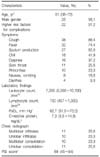Abstract
Background
A novel 2009 influenza A (H1N1) virus emerged and disseminated to all over the world. There are few reports on the clinical characteristics of patients with complications. We describe the clinical features of pneumonia in adult patients hospitalized, who have novel influenza infection.
Methods
There were 43 adult patients enrolled into the study with pneumonia of 528 hospitalized patients confirmed influenza A (H1N1) virus infection by real-time reverse transcriptase polymerase chain reaction testing, between 24 August 2009 and 31 January 2010. The clinical data of patients with pneumonia were collected retrospectively.
Results
There were 22 of 43 (51.2%) influenza patients with pneumonia that had higher risk factors for complications. Compared to 28 patients with influenza A (H1N1) viral pneumonia and 15 patients, who had isolated bacteria from cultures, those with mixed viral and bacterial pneumonia were significantly more likely to have unilobar consolidations on chest radiographs (53.3 vs. 10.7%, p<0.01) and higher scores of pneumonia severity index (PSI; 90 [66~100] vs. 53 [28~90], p=0.04). Six patients required mechanical ventilation support in an Intensive Care Unit and were more likely to have dyspnea (83.3 vs. 29.3%, p=0.02) and low levels of PaO2 (48.3 [37.0~70.5] vs 64.0 [60.0~74.5] mm Hg, p=0.02) and high levels of pneumonia severity index (PSI) score (108.0 [74.5~142.8] vs. 56.0 [40.5~91.0], p=0.03).
Conclusion
The majority of pneumonia patients infected with novel influenza improved. Chest radiographic findings of unilobar consolidations suggest that mixed pneumonia is more likely. Initial dyspnea, hypoxemia, and high levels of PSI score are associated with undergoing mechanical ventilation support.
Figures and Tables
Table 1
Baseline clinical characteristics of the 43 patients with pneumonia in novel influenza A (H1N1) infection

References
1. Fraser C, Donnelly CA, Cauchemez S, Hanage WP, Van Kerkhove MD, Hollingsworth TD, et al. Pandemic potential of a strain of influenza A (H1N1): early findings. Science. 2009. 324:1557–1561.
2. Turbelin C, Pelat C, Boëlle PY, Lévy-Bruhl D, Carrat F, Blanchon T, et al. Early estimates of 2009 pandemic influenza A (H1N1) virus activity in general practice in France: incidence of influenza-like illness and age distribution of reported cases. Euro Surveill. 2009. 14(39):pii: 19341.
3. Garske T, Legrand J, Donnelly CA, Ward H, Cauchemez S, Fraser C, et al. Assessing the severity of the novel influenza A/H1N1 pandemic. BMJ. 2009. 339:b2840.
4. World now at the start of 2009 influenza pandemic. World Health Organization. 2009. cited 2009 Aug 24. Geneva: World Health Organization;Available from: http://www.who.int/mediacentre/news/statements/2009/h1n1_pandemic_phase6_20090611/en/index.html.
5. Korea Centers for Disease Control and Prevention. Cases of novel influenza A (H1N1) infections in the South Korea. Public Health Weekly Report. 2009. 2:293–295.
6. Korea Centers for Disease Control and Prevention. Weekly acute infectious disease pathogen surveillance: acute respiratory virus. Pathogen Lab Surveillance Report. week 45.
7. Dolin R. Fauci AS, Braunwald E, Kasper DL, Hauser SL, Longo DL, Jameson JL, editors. Chapter 180. Influenza. Harrison's principles of internal medicine. 2008. 17th ed. New York: McGraw-Hill Co., Inc;1127–1132.
8. Kim SH. Treatment of severe pandemic influenza A/H1N1 infection. Infect Chemother. 2009. 41:265–271.
9. Rothberg MB, Haessler SD. Complications of seasonal and pandemic influenza. Crit Care Med. 2010. 38:e91–e97.
10. Ahn S, Kim WY, Yoon JY, Sohn CH, Seo DW, Kim SH, et al. Procalcitonin in 2009 H1N1 influenza pneumonia: role in differentiating from bacterial pneumonia. Tuberc Respir Dis. 2010. 68:205–211.
11. Dawood FS, Jain S, Finelli L, Shaw MW, Lindstrom S, Garten RJ, et al. Emergence of a novel swine-origin influenza A (H1N1) virus in humans. N Engl J Med. 2009. 360:2605–2615.
12. Garten RJ, Davis CT, Russell CA, Shu B, Lindstrom S, Balish A, et al. Antigenic and genetic characteristics of swine-origin 2009 A(H1N1) influenza viruses circulating in humans. Science. 2009. 325:197–201.
13. Zimmer SM, Burke DS. Historical perspective: emergence of influenza A (H1N1) viruses. N Engl J Med. 2009. 361:279–285.
14. Kim WJ. Epidemiology, clinical manifestations, and management of pandemic novel Influenza A (H1N1). Korean J Med. 2009. 77:157–164.
15. Lee CS. The diagnosis and treatment of influenza. J Korean Med Assoc. 2010. 53:43–51.
16. Noh JY, Yim SY, Heo JY, Choi WS, Song JY, Cheong HJ, et al. Epidemiological and clinical characteristics of pandemic influenza (H1N1 2009). Infect Chemother. 2010. 42:69–75.
17. Choi SS, Kim WY, Kim SH, Hong SB, Lim CM, Koh Y, et al. Associated factor related to major complications of patients with hospitalized for 2009 H1N1 influenza pneumonia. Tuberc Respir Dis. 2010. 68:162–167.
18. Bautista E, Chotpitayasunondh T, Gao Z, Harper SA, Shaw M, Uyeki TM, et al. Clinical aspects of pandemic 2009 influenza A (H1N1) virus infection. N Engl J Med. 2010. 362:1708–1719.
19. Center for Disease Control and Prevention (CDC). Intensive care patients with severe novel influenza A (H1N1) virus infection: Michigan, June 2009. MMWR Morb Mortal Wkly Rep. 2009. 58:749–752.
20. Dwyer D. Mini-lecture in slide session on novel H1N1 influenza: late-breakers. In : Program and abstracts of the 49th Interscience Conference on Antimicrobial Agents and Chemotherapy; 2009 Sep 12-15; San Francisco, CA, USA.
21. Rello J, Rodríguez A, Ibañez P, Socias L, Cebrian J, Marques A, et al. Intensive care adult patients with severe respiratory failure caused by Influenza A (H1N1)v in Spain. Crit Care. 2009. 13:R148.
22. Centers for Disease Control and Prevention (CDC). Surveillance for pediatric deaths associated with 2009 pandemic influenza A (H1N1) virus infection-Unites States, April-August 2009. MMWR Morb Mortal Wkly Rep. 2009. 58:941–947.
23. Wright PF, Kirkland KB, Modlin JF. When to consider the use of antibiotics in the treatment of 2009 H1N1 influenza-associated pneumonia. N Engl J Med. 2009. 361:e112.
24. Barlow GD. Swine flu and antibiotics. J Antimicrob Chemother. 2009. 64:889–894.




 PDF
PDF ePub
ePub Citation
Citation Print
Print




 XML Download
XML Download